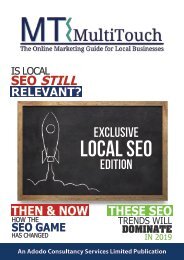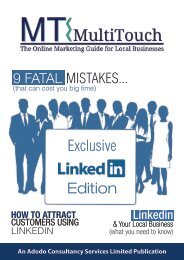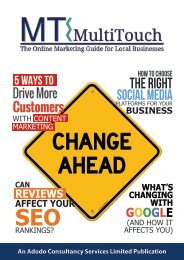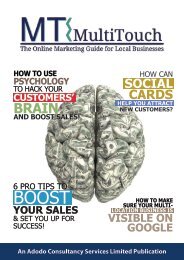mt-magazine-Mar18
You also want an ePaper? Increase the reach of your titles
YUMPU automatically turns print PDFs into web optimized ePapers that Google loves.
1<br />
Backlinks to Quality Sites Still<br />
Carry Weight<br />
In a Q & A session from March of 2017, Google<br />
revealed their top three ranking factors. Backlinks<br />
were number one. Since Google rarely comments<br />
publicly about their algorithm, we can’t<br />
say for certain that backlinks are still number<br />
one, but it’s safe to assume they’re very close to<br />
the top.<br />
A backlink is any link that leads from another site<br />
to yours. If you want backlinks to have a positive<br />
impact on your Google rank, they must be from<br />
authority sites. Multiple links from the same site<br />
won’t help you since Google evaluates backlinks<br />
based on domains, not volume.<br />
Remember that spammy backlinks won’t<br />
help you. In fact, they may hurt you. When a<br />
low-quality site links to yours, Google may associate<br />
your quality site with their low-quality<br />
content or practices. Instead of buying links or<br />
engaging in other “black hat” practices, focus on<br />
organically building quality links.<br />
2<br />
Content is Still King<br />
The next most important ranking factor is your content. Google’s aim is to provide highly relevant,<br />
quality content to searchers. The better your content is, the more likely it is that your site will rise<br />
to the top of the SERP.<br />
Not all quality is created equal. You can signal quality to Google by doing the following things:<br />
Use keywords properly. Keyword stuffing won’t<br />
help you, but using keywords in your URL, title<br />
tag, H1/H2 tags, alt tags, and in the first paragraph<br />
of your content will.<br />
Make your content long enough to be satisfying. There’s no<br />
specific word count to aim for. Instead, your goal should be<br />
providing visitors to your site with the information they’re<br />
looking for. If you do that, they’ll be satisfied<br />
– and your rank will reflect it.<br />
Make your content comprehensible.<br />
By that, we<br />
don’t mean making<br />
sure people can read<br />
it. Rather, it has to<br />
do with providing<br />
context for your<br />
content. The use<br />
of Latent Semantic<br />
Indexing (LSI)<br />
words can help. In<br />
other words, remember<br />
that your content<br />
doesn’t exist in a vacuum.<br />
To earn a high rank on Google, your<br />
content must be relevant and engaging.<br />
If people who find your site<br />
through Google are happy with your<br />
content, they’ll show it by staying on<br />
your page and engaging with your content.<br />
Their behavior in relation to your content<br />
– combined with the other content<br />
factors here – will tell Google what it needs<br />
to know about your site.

















